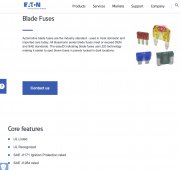Neither I nor anyone else in this thread has suggested cutting corners on safety. Having retreated from the factually baseless claim that BlueSea's circuit protection designs are legally required, the same person has now suggested that distinguishing between marine and land needs, and questioning the pricing of BlueSea's products, compared to prices from the inventors of the products, is being "cheap" and compromises safety.
Littelfuse and Eaton/Bussmann have been leaders in the development and production of circuit protection products throughout their history. Blue Sea is in the pleasure craft business. It, and indeed Victron, basically rebrand circuit protection products that Littelfuse and Bussmann invented and sell them for more money. Victron has just released a video about its fuse holders that touts features that Littelfuse holders have had for many years.
For example, and as stated earlier, Littelfuse itself makes fuse holders that provide full ignition protection. They are typically used in commercial vehicles transporting dangerous goods. Eaton/Bussmann makes similar products. Interestingly, Eaton also says, specifically, that its in-line blade fuses, which include 80A and 100A fuses, provide ignition protection to SAE standards (see the first screen capture). These SAE standards are the exact same standards recommended by the American Boat and Yacht Council for gasoline-powered inboard engines on boats and yachts.
It is beyond me why someone would think that Blue Sea's fuse holders and fuses are somehow "better" than what Littelfuse and Eaton/Bussmann make. The idea appears to be a tribute to BlueSea marketing and Internet forum group-think. If Littelfuse and Eaton/Bussmann products are competitive with their aftermarket imitators on price, it isn't because they aren't as good, it's because their market consists of hundreds and hundreds of millions of motor vehicle owners, not just boat owners. Personally, I also have greater confidence in Littelfuse/Bussmann quality control.
I wonder how many people here know that Brunswick Corporation is the actual owner of Blue Sea, and that the latter is not some little independent company in Bellingham, Washington. Many people will be familiar with the name Brunswick. Historically, its main business was making billiard tables, bowling machines and bowling balls. Like the conglomerate that it is (remember when conglomerates were a trendy way to make a fast buck?), it has also dabbled (what follows is by no means an exhaustive list) in toilet seats, automobile tires, phonograph records, furniture for schools, assault weapons and boats.
Last year, Brunswick decided that being a conglomerate isn't a great long-term business model (something that has been common knowledge for decades) and decided to concentrate on its marine businesses. Over the last few years, it has been on a buying spree in an effort to corner the market on certain marine segments, including wiring and electrical.
The electrical part of this buying spree is done through a Brunswick Corporation subsidiary called BEP Marine. BEP is based in Auckland, New Zealand. It is the parent company of Blue Sea, which Brunswick purchased in 2014. As the second screen capture shows, BEP is also the owner of several other marine electrical brands, and a couple of RV brands. Buying all the players is what you do if you want to control production, cost and ultimately price in an entire business segment.
Personally, I'll stick with Littelfuse and Eaton/Bussmann unless there's a specific, fact-based reason to look elsewhere. I respect the fact that they invented these fuse formats. I prefer to support people who have a long track record of research, development and innovation, especially when what they offer is competitive on price. They not only make very good holders, they make holders that aren't even made by aftermarket firms, such as Blue Sea and Victron, that sell into niche markets. As stated above, I also have greater confidence in Littelfuse/Bussmann quality control when it comes to fuses. Finally, I think that what Brunswick Corporation is doing is blatantly anti-competitive and that this results in higher prices. While I'm prepared to purchase Ancor wire, in particular, I'm not looking for reasons to give Brunswick Corporation my money.
The idea that I look first to Littelfuse and Eaton/Bussmann because I'm "cheap", and that I endorse cutting corners on safety, is as baseless as the original claim about legal requirements. It's not only baseless, it is itself cheap, the kind of ad hominem personal attack that people resort to when they can't think of anything better.







